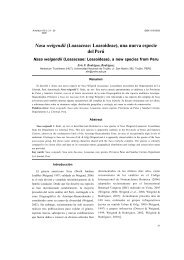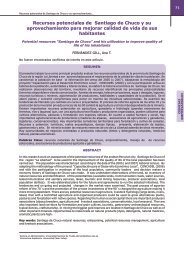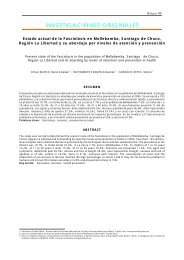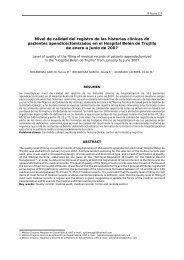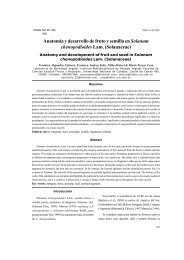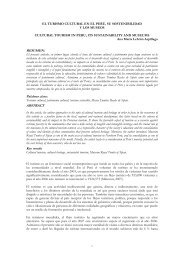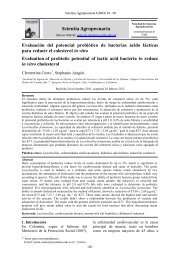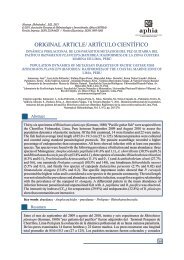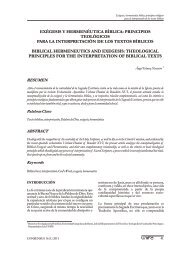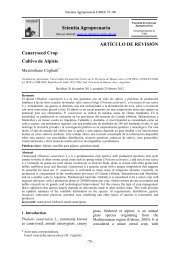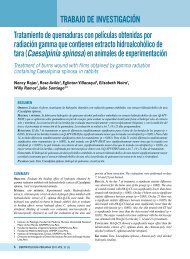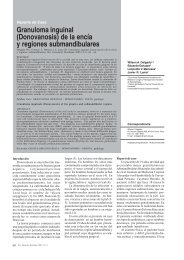evaluación de la calidad del agua de consumo ... - Revista Peruana
evaluación de la calidad del agua de consumo ... - Revista Peruana
evaluación de la calidad del agua de consumo ... - Revista Peruana
Create successful ePaper yourself
Turn your PDF publications into a flip-book with our unique Google optimized e-Paper software.
EVALUACIÓN DE LA CALIDAD DEL AGUA DE CONSUMO<br />
HUMANO DE SHANCAYÁN Y ANEXOS.<br />
E<strong>de</strong>ll Doriza Aliaga Zegarra*, Edson Gilmar Yupanqui Torres*, Edgar Pedro Olivera De <strong>la</strong> Cruz*,<br />
Flormi<strong>la</strong> Violeta Vicuña Pérez*<br />
RESUMEN<br />
En el presente trabajo tiene por finalidad evaluar <strong>la</strong> <strong>calidad</strong> <strong>de</strong>l <strong>agua</strong> <strong>de</strong> <strong>consumo</strong> <strong>de</strong> Shancayán y anexos <strong>de</strong>l Distrito <strong>de</strong><br />
In<strong>de</strong>pen<strong>de</strong>ncia <strong>de</strong> <strong>la</strong> Provincia <strong>de</strong> Huaraz, RegiónAncash, Perú.<br />
Estos parámetros han sido <strong>de</strong>terminados en base a los métodos normalizados (1), y contrastados con los límites<br />
máximos permitidos por <strong>la</strong> OMS (3), llegando a <strong>la</strong> conclusión <strong>de</strong> que el <strong>agua</strong> <strong>de</strong> <strong>consumo</strong> <strong>de</strong> Shancayán y anexos es apta<br />
para su <strong>consumo</strong>.<br />
Para cumplir con el objetivo <strong>de</strong> evaluar <strong>la</strong> <strong>calidad</strong> <strong>de</strong>l <strong>agua</strong> se <strong>de</strong>terminaron 7 puntos <strong>de</strong> muestreo en cada uno <strong>de</strong> los<br />
cuales se realizaron dos muestreos: Uno en época <strong>de</strong> lluvia y otro en estiaje, a<strong>de</strong>más se midieron 25 parámetros entre<br />
características físicas, químicas y microbiológicas, como son: turbie<strong>de</strong>z, temperatura, conductividad, sólidos totales<br />
secados a 103-105°C, sólidos totales disueltos a 180°C, alcalinidad a <strong>la</strong> fenolftaleína, alcalinidad al anaranjado <strong>de</strong><br />
metilo, dureza total, aci<strong>de</strong>z total, pH, cloro residual, cloruros, fluoruros, sulfatos, fosfatos, nitratos, aluminio, arsénico,<br />
cadmio, hierro, mercurio, plomo, potasio, coliformes totales y coliformes fecales; los que son los parámetros más<br />
usuales para <strong>la</strong> evaluación <strong>de</strong> <strong>la</strong> <strong>calidad</strong> <strong>de</strong> <strong>agua</strong> para el <strong>consumo</strong> humano. En este proceso se emplearon los métodos<br />
normalizados propuestos por <strong>la</strong> APHA, AWWA, WCPF. Los resultados obtenidos se compararon con <strong>la</strong>s normas<br />
establecidas por <strong>la</strong> OMS a fin <strong>de</strong> <strong>de</strong>terminar <strong>la</strong> <strong>calidad</strong> <strong>de</strong>l <strong>agua</strong>.<br />
De acuerdo a los criterios <strong>de</strong> <strong>calidad</strong> <strong>de</strong> <strong>la</strong>s <strong>agua</strong>s crudas propuesto por <strong>la</strong> OMS, el <strong>agua</strong> <strong>de</strong> Shancayán y anexos,<br />
pertenece al grupo II,<br />
por tanto no es apto para el <strong>consumo</strong> humano en forma directa pero sí previo tratamiento <strong>de</strong><br />
potabilización.<br />
- Calidad <strong>de</strong> <strong>agua</strong>,Agua <strong>de</strong> <strong>consumo</strong> humano, Parámetros <strong>de</strong> <strong>calidad</strong><br />
Evaluation the quality of the water of consumption of the neighborhood of Ahancayán and<br />
annexes<br />
ABSTRACT<br />
Presently work has for purpose to evaluate the quality of the water of consumption of the neighbourhood of Shancayán<br />
and annexes of the district of In<strong>de</strong>pen<strong>de</strong>nce of the county of Huaraz, regionAncash, Peru.<br />
These parameters have been <strong>de</strong>termined based on the normalized methods, it In<strong>de</strong>xes 1 and contrasted with the<br />
maximum limits allowed by OMS, it In<strong>de</strong>xes 3, reaching the conclusion that the water of consumption of Shancayán and<br />
annexes are capable for their consumption.<br />
To fulfill the objective of evaluating the quality of the water 7 sampling points they were <strong>de</strong>termined in each one of which<br />
were carried out two samplings: One in rain time and another in low water, 25 parameters were also measured between<br />
physical, chemical characteristics and microbiologicals, like they are: turbie<strong>de</strong>z, temperature, conductivity, solids total<br />
dryings at 103-105°C, total dissolved solids at 180°C, alkalinity to the phenolphthalein, alkalinity to the orange of<br />
methyl, total hardness, total acidity, pH, residual chlorine, chlori<strong>de</strong>s, fluori<strong>de</strong>s, sulfates, phosphates, nitrates, aluminum,<br />
arsenic, cadmium, iron, mercury, lead, potassium, total coliformes and fecal coliformes; those that are the most usual<br />
parameters for the evaluation of the quality of water for the human consumption. In this process the normalized methods<br />
were used proposed by APHA, AWWA, WCPF. The obtained results were compared with the norms settled down by<br />
OMS in or<strong>de</strong>r to <strong>de</strong>termine the quality of the water.<br />
According to the approaches of quality of the raw waters proposed by OMS, the water of Shancayan and annexes, it<br />
belongs to the group II; therefore it is not capable for the human consumption in direct form but yes previous<br />
potabilizacion treatment.<br />
- Quality of water, Water of consumption, Parameter of quality<br />
* Docentes <strong>de</strong> <strong>la</strong> Facultad <strong>de</strong> Ciencias - UNASAM<br />
43
INTRODUCCIÓN<br />
El presente trabajo <strong>de</strong> investigación se realiza con el propósito <strong>de</strong> <strong>de</strong>terminar <strong>la</strong> <strong>calidad</strong> <strong>de</strong>l <strong>agua</strong> <strong>de</strong> <strong>la</strong> jurisdicción <strong>de</strong> <strong>la</strong><br />
Junta Administradora Autónoma <strong>de</strong> Agua Potable <strong>de</strong> Sancayán y anexos (JAAAPSHAN), motivados por <strong>la</strong><br />
incertidumbre <strong>de</strong> <strong>la</strong> pob<strong>la</strong>ción sobre <strong>la</strong> <strong>calidad</strong> <strong>de</strong>l <strong>agua</strong>.<br />
Siendo uno <strong>de</strong> los roles <strong>de</strong> <strong>la</strong> UNASAM y por en<strong>de</strong> <strong>de</strong> sus profesionales contribuir en <strong>la</strong> solución <strong>de</strong> los problemas <strong>de</strong> <strong>la</strong><br />
comunidad, se toma <strong>la</strong> <strong>de</strong>cisión <strong>de</strong> realizar el trabajo <strong>de</strong> investigación que lo <strong>de</strong>nominamos “EVALUACIÓN DE LA<br />
CALIDAD DEL AGUA DE CONSUMO HUMANO DE SHANCAYÁN Y ANEXOS”, p<strong>la</strong>nteándonos <strong>la</strong> siguiente<br />
hipótesis: El <strong>agua</strong> <strong>de</strong> <strong>consumo</strong> <strong>de</strong> Shancayán podría presentar parámetros físicos, químicos y microbiológicos que no<br />
están <strong>de</strong> acuerdo con <strong>la</strong>s normas, como consecuencia <strong>de</strong> múltiples factores: Arrastre excesivo <strong>de</strong> sólidos, metales y<br />
bacterias <strong>de</strong>bido al po<strong>de</strong>r <strong>de</strong> solubilidad que tiene el <strong>agua</strong>. Para conocer <strong>la</strong> <strong>calidad</strong> <strong>de</strong> ésta <strong>agua</strong> se diseña <strong>la</strong> siguiente<br />
metodología: Se ubicaron estratégicamente siete puntos <strong>de</strong> muestreo que compren<strong>de</strong>n <strong>de</strong>s<strong>de</strong> <strong>la</strong> captación hasta <strong>la</strong>s re<strong>de</strong>s<br />
<strong>de</strong> distribución. Estas muestras se tomaron en época <strong>de</strong> lluvias y en estiaje, con <strong>la</strong> finalidad <strong>de</strong> comparar <strong>la</strong> variabilidad <strong>de</strong><br />
los parámetros en estas épocas <strong>de</strong>l año bien marcadas en esta región. Se seleccionaron 25 parámetros entre físicos,<br />
químicos y microbiológicos que son los más usuales en este tipo <strong>de</strong> muestras, comparando los resultados con <strong>la</strong>s normas<br />
<strong>de</strong> <strong>la</strong> OMS, concluyendo que <strong>la</strong> fuente <strong>de</strong> captación pertenece al Grupo II, La cual requiere <strong>de</strong> tratamiento convencional,<br />
tal como coagu<strong>la</strong>ción, sedimentación, filtración rápida y <strong>de</strong>sinfección antes <strong>de</strong> ser utilizado para su <strong>consumo</strong> humano.<br />
Los métodos <strong>de</strong> análisis fueron los normalizados para análisis <strong>de</strong> <strong>agua</strong>s potables y residuales <strong>de</strong> <strong>la</strong> APHA, AWWA y<br />
WPCF.<br />
MATERIALESYMÉTODO<br />
Los análisis <strong>de</strong> <strong>la</strong>s características físicas y químicas se realizaron en el Laboratorio <strong>de</strong> Química UNASAM, <strong>la</strong>s<br />
características microbiológicas y contenidas <strong>de</strong> metales en el Laboratorio <strong>de</strong> Calidad Ambiental <strong>de</strong> <strong>la</strong> FCAM-<br />
UNASAM<br />
Las muestras para el análisis se tomaron en siete puntos en período <strong>de</strong> lluvia y en estiaje<br />
<br />
<br />
<br />
<br />
<br />
<br />
<br />
Los instrumentos utilizados fueron:<br />
<br />
<br />
<br />
<br />
<br />
<br />
<br />
<br />
<br />
<br />
Punto Nº 1 : En <strong>la</strong> Bocatoma <strong>de</strong> captación <strong>de</strong>Yarush (Muestra Nº 1)<br />
Punto Nº 2 : En entrada P<strong>la</strong>nta <strong>de</strong> Marian, <strong>de</strong>l <strong>agua</strong> (Muestra Nº 2)<br />
Punto Nº 3 : En salida P<strong>la</strong>nta <strong>de</strong> Marian, <strong>de</strong>l <strong>agua</strong> (Muestra Nº 3)<br />
Punto Nº 4 : En Reservorio <strong>de</strong> Shekpa, (Muestra Nº 4)<br />
Punto Nº 5 : Ciudad Universitaria <strong>de</strong> Shancayán UNASAM (Muestra Nº 5).<br />
Punto Nº 6 : Jr. Los Membrillo en el barrio <strong>de</strong> Shancayán (Muestra Nº 6)<br />
Punto Nº 7 : Jr. LosAn<strong>de</strong>nes en <strong>la</strong> Urbanización el Mirador (Muestra Nº 7)<br />
Turbidímetro : Hanna Hi93703<br />
Conductimetro : YSI Incorporated Mo<strong>de</strong>l 30/25FT<br />
pH metro : Hanna Instrumentos Hi8424<br />
Espectrofotómetro UV-V : Spectronic 22<br />
Espectrofotómetro V : Nova 60<br />
Equipo <strong>de</strong> titu<strong>la</strong>ción : Buretas calibradas<br />
Ba<strong>la</strong>nza analítica : Sartorius BA 160 P<br />
Estufa eléctrica : Memmert <strong>de</strong> 0 a 220°C.<br />
Termómetro <strong>de</strong> mercurio : Esca<strong>la</strong> <strong>de</strong> –10°C a 110°C.<br />
Contador <strong>de</strong> colonias : Funke Gerber.<br />
El <strong>agua</strong> y los reactivos químicos usados para <strong>la</strong> preparación <strong>de</strong> soluciones cumplen con lo establecido en <strong>la</strong>s técnicas<br />
1070 D. (15); <strong>la</strong> toma <strong>de</strong> muestra y conservación se realizó según <strong>la</strong> Norma 1060B (15 y 16),<br />
La temperatura, pH, conductividad, y turbi<strong>de</strong>z. se realizaron in situ (16).<br />
Los métodos analíticos utilizados en el presente trabajo fueron: gravimétrico, volumétrico e instrumental. (11, 12, 13, 14<br />
y 15).<br />
44
RESULTADOS<br />
En <strong>la</strong>s tab<strong>la</strong>s 4, 6 y 8 se muestran los resultados <strong>de</strong> <strong>la</strong>s características microbiológicas, físicas y químicas <strong>de</strong>l <strong>agua</strong> en <strong>la</strong><br />
primera fecha <strong>de</strong> muestreo que correspon<strong>de</strong> al período <strong>de</strong> lluvia; mientras que en <strong>la</strong>s tab<strong>la</strong>s 5, 7 y 9 se muestran los<br />
resultados <strong>de</strong> <strong>la</strong>s mismas características <strong>de</strong>l <strong>agua</strong> en <strong>la</strong> segunda fecha <strong>de</strong> muestreo y correspon<strong>de</strong> a <strong>la</strong> época <strong>de</strong> estiaje en<br />
los diferentes puntos <strong>de</strong> muestreo <strong>de</strong>terminados para este trabajo <strong>de</strong> investigación.<br />
TABLA 4:RESULTADOS DE LAS CARACTERÍSTICAS MICROBIOLÓGICAS<br />
DEL AGUA EN LOS PUNTOS ESTABLECIDOS, PERÍODO DE LLUVIA<br />
PARÁMETRO UNIDAD M1 M2 M3 M4<br />
Coniformes totales<br />
(CT)<br />
M5 M6 M7<br />
Valor<br />
OMS<br />
NMP/100 240 23 0 0 0 0 0 0<br />
Coniformes fecales<br />
NMP/100 240 23 0 0 0 0 0 0<br />
(CF)<br />
Fuente: Resultados <strong>de</strong> los análisis obtenidos en <strong>la</strong>boratorio<br />
TABLA 5: RESULTADOS DE LAS CARACTERÍSTICAS MICROBIOLÓGICAS<br />
DEL AGUA EN LOS PUNTOS ESTABLECIDOS,PERÍODO DE ESTIAJE<br />
PARÁMETRO UNIDAD M1 M2 M3 M4 M5 M6 M7<br />
Coliformes totales<br />
(CT)<br />
NMP/100 240 460 0 0 0 0<br />
Valor<br />
OMS<br />
0 0<br />
Coliformes fecales<br />
NMP/100 240 460 0 0 0 0 0 0<br />
(CF)<br />
Fuente: Resultados <strong>de</strong> los análisis obtenidos en <strong>la</strong>boratorio<br />
TABLA 6 : RESULTADOS DE LAS CARACTERÍSTICAS FÍSICAS DEL AGUA<br />
EN LOS PUNTOS ESTABLECIDOS, PERÍODO DE LLUVIA<br />
Valor<br />
PARÁMETRO UNIDAD M1 M2 M3 M4 M5 M6 M7<br />
OMS<br />
Temperatura ºC 8,50 10,00 10,00 10,00 15,00 11,00 10,20 ---<br />
Turbi<strong>de</strong>z UNT 12,00 12,00 11,00 10,00 10,00 10,00 10,00 25<br />
Conductividad µS/m 160 76 71 67 61 59 59 250<br />
Sólidos en suspensión: mg/L 18 1 1 4 1 1 1 ---<br />
Sólidos disueltos: mg/L 50 50 60 40 50 60 60 1500<br />
Fuente: Resultados <strong>de</strong> los análisis obtenidos in situ y en <strong>la</strong>boratorio<br />
TABLA 7 : RESULTADOS DE LAS CARACTERÍSTICAS FÍSICAS DEL AGUA<br />
EN LOS PUNTOS ESTABLECIDOS, PERÍODO DE ESTIAJE<br />
Valor<br />
PARÁMETRO UNIDAD M1 M2 M3 M4 M5 M6 M7<br />
OMS<br />
Temperatura ºC 9,00 10,50 11,00 9,80 16,00 15,00 10,00 ---<br />
Turbi<strong>de</strong>z UNT 10,00 9,00 10,00 9,00 8,00 9,00 9,00 25<br />
Conductividad µS/m 71,20 71,40 72,30 73,80 72,30 72,10 71,00 250<br />
Sólidos en suspensión mg/L 1 1 3 4 4 2 1 ---<br />
45
TABLA 8 : RESULTADOS DE LAS CARACTERÍSTICAS QUÍMICAS, ANIONES Y CATIONES DEL<br />
AGUA EN LOS PUNTOS ESTABLECIDOS, PERÍODO DE LLUVIA<br />
PARÁMETRO<br />
UNIDAD M1 M2 M3 M4 M5 M6 M7 Valor OMS<br />
Alcalinidad a <strong>la</strong> fenolftaleína mg CO3 -2 /L 0,00 0,00 0,00 0,00 0,00 0,00 6,30 ---<br />
Alcalinidad al anaranjado <strong>de</strong> metilo mg CO3 -2 /L 6,30 6,30 6,30 6,30 7,60 4,80 4,80 ---<br />
Dureza total mg CaCO3/L 20,84 54,18 58,35 58,35 45,85 54,18 91,70 500<br />
Aci<strong>de</strong>z total mg CO3 -2 /L 0,24 0,24 0,24 0,24 0,24 0,24 0,61 ---<br />
Ph pH 7,09 7,31 7,24 7,21 7,34 7,39 7,27 6,5-8,5<br />
Cloro residual mg Cl2/L 0,05 0,05 0,50 0,50 0,50 0,25 0,50 ---<br />
Fluoruros mg F - /L 0,86 0,84 0,90 0,98 0,98 0,99 0,99 1,5<br />
Cloruros mg Cl - /L 7,10 10,60 7,10 7,10 10,60 7,10 10,60 250<br />
Sulfatos mg SO4 -2 /L 1,84 1,03 1,00 1,03 0,97 1,06 1,72 250-500<br />
Nitratos mg NO3 - /L 0,50 0,70 0,70 0,60 0,70 1,50 1,50 50<br />
Fosfato mg PO4 -3 /L 0,50 0,50 0,50 0,60 0,50 0,70 0,50 ---<br />
Aluminio disuelto mg Al/L 0,020 0,020 0,048 0,020 0,020 0,020 0,020 0,20<br />
Arsénico disuelto mg As/L 0,05 0,05 0,045 0,009 5 0,009 0,01 0,009 8 0,01<br />
Cadmio disuelto mg Cd/L 0,002 0,002 0,002 0,003 0,003 0,002 0,002 0,003-0,005<br />
Fierro disuelto mg Fe/L 0,080 0,090 0,080 0,090 0,090 0,080 0,120 0,30<br />
Mercurio disuelto mg Hg/L ND ND ND ND ND ND ND 0,001<br />
Pb disuelto mg Pb/L 0,10 0,10 0,10 0,08 0,08 0,08 0,07 0,01<br />
Potasio disuelto mg K/L 5,00 5,00 5,00 5,00 5,00 5,00 5,00 ---<br />
Fuente: Resultados <strong>de</strong> los análisis obtenidos en <strong>la</strong>boratorio<br />
Los parámetros: Al y As se trabajaron con b<strong>la</strong>ncos por lo que al resultado <strong>de</strong>l reporte se le restó los siguientes valores en mg/L:<br />
B<strong>la</strong>nco <strong>de</strong>l Al = 0.062<br />
B<strong>la</strong>nco <strong>de</strong>l As = 0.05<br />
ND = No <strong>de</strong>tectado por el instrumento<br />
46
TABLA 9 : RESULTADOS DE LAS CARACTERÍSTICAS QUÍMICAS DEL AGUA EN LOS PUNTOS ESTABLECIDOS,<br />
PERÍODO DE ESTIAJE<br />
PARÁMETRO UNIDAD M1 M2 M3 M4 M5 M6 M7 Valor OMS<br />
Alcalinidad a <strong>la</strong> fenolftaleína -2<br />
mg CO 3 /L 0,00 0,00 0,00 0,00 0,00 0,00 6,30 ---<br />
Alcalinidad al anaranjado <strong>de</strong><br />
-2<br />
mg CO metilo<br />
3 /L 6,00 6,00<br />
6,00 6,30 6,30 4,50 4,50 ---<br />
Dureza total mg CaCO 3 /L 45,85 54,18 54,18 54,18 58,35 58,35 83,36 500<br />
Aci<strong>de</strong>z total Mg CO 3<br />
-2 /L 0,24 0,24 0,24 0,24 0,24 0,24 0,60 ---<br />
pH pH 7,49 7,51 7,41 7,39 7,32 7,34 7,39 6,5-8,5<br />
Cloro residual mg Cl 2 /L 0,05 0,05 0,50 0,05 0,25 0,05 0,25 ---<br />
Fluoruros mg F - /L 0,94 0,98 0,94 0,91 0,65 0,91 0,91 1,5<br />
Cloruros mg Cl - /L 7,10 7,10 7,10 7,10 7,10 7,10 7,10 250<br />
Sulfatos mg SO 4<br />
-2 /L 1,36 1,76 1,78 1,12 1,07 1,06 1,32 250-500<br />
Nitratos mg NO 3<br />
- /L 0,40 0,20 0,50 0,70 0,60 0,90 0,50 50<br />
Fosfato mg PO 4<br />
-3 /L 0,70 0,60 0,50 0,50 0,50 0,60 0,60 ---<br />
Aluminio disuelto mg Al/L 0,020 0 ,020 0,020 0,050 0,020 0,040 0,030 0,20<br />
Arsénico disuelto mg As/L 0,009 7 0,009 0,009 0,009 0,009 0,0093 0,009 0,01<br />
Cadmio disuelto mg Cd/L 0,002 0,002 0,002 6 0,002 0,002 0,002 0,002 0,003-0,005<br />
Fierro disuelto mg Cd/L 0,080 0,060 0,070 0,060 0,060 0,130 0,080 0,30<br />
Mercurio disuelto mg Hg/L ND ND ND ND ND ND ND 0,001<br />
Plomo disuelto mg Pb/L 0,060 0,070 0,060 0,060 0,060 0,070 0,070 0,01<br />
Potasio disuelto mg K/L 5,00 5,00 5,00 5,00 5,00 5,00 5,00 ---<br />
Fuente: Resultados <strong>de</strong> los análisis obtenidos en <strong>la</strong>boratorio<br />
Los parámetros: Cd, Hg, Pb y As se trabajaron con b<strong>la</strong>ncos por ser parámetros problema por lo que al resultado <strong>de</strong>l reporte se le restó los<br />
siguientes valores en mg/L:<br />
B<strong>la</strong>nco <strong>de</strong>l Cd = 0.029 B<strong>la</strong>nco <strong>de</strong>l Hg = 0.194 B<strong>la</strong>nco <strong>de</strong>l Pb = 0.24 B<strong>la</strong>nco <strong>de</strong>l As = 0.069<br />
47
DISCUSIÓN<br />
Al realizar el análisis <strong>de</strong> los resultados <strong>de</strong> los parámetros físicos, químicos y microbiológicos y contrastándolos con los<br />
valores establecidos por <strong>la</strong> OMS se tiene que <strong>la</strong> turbi<strong>de</strong>z, conductividad, sólidos disueltos, dureza, pH, fluoruros,<br />
cloruros, sulfatos, nitratos, aluminio, arsénico, cadmio, hiero, mercurio, plomo y coliformes se encuentran <strong>de</strong>ntro <strong>de</strong> los<br />
límites establecidos por ésta norma en ambos periodos en los que se realizaron los muestreos.<br />
CONCLUSIONES<br />
1. El <strong>agua</strong> <strong>de</strong> <strong>la</strong> fuente <strong>de</strong> Shancayán y anexos, <strong>de</strong> acuerdo a los criterios establecidos por el Servicio <strong>de</strong> Salud Pública<br />
<strong>de</strong> los EE. UU., y conforme a <strong>la</strong> Guías Internacionales <strong>de</strong> <strong>agua</strong> potable <strong>de</strong> <strong>la</strong> OMS, pertenece al Grupo II <strong>de</strong> <strong>agua</strong>s<br />
crudas, por tanto para ser utilizada en el <strong>consumo</strong> humano <strong>de</strong>be someterse a un previo tratamiento <strong>de</strong> potabilización<br />
convencional tal como coagu<strong>la</strong>ción, sedimentación, filtración rápida y <strong>de</strong>sinfección (post cloración) o filtración<br />
lenta y sedimentación (post cloración).<br />
2.<br />
3.<br />
4.<br />
El <strong>agua</strong> <strong>de</strong> Shancayán y anexos está entre <strong>la</strong>s <strong>agua</strong>s b<strong>la</strong>ndas <strong>de</strong> acuerdo a <strong>la</strong> c<strong>la</strong>sificación <strong>de</strong> Dorier, por tanto se<br />
consi<strong>de</strong>ra como un <strong>agua</strong> <strong>de</strong> buena <strong>calidad</strong>.<br />
El <strong>agua</strong> <strong>de</strong> Shancayán y anexos se cataloga como un <strong>agua</strong> <strong>de</strong> mineralización media a importante, lo cual es una<br />
condición favorable para el <strong>consumo</strong> humano.<br />
No existen coliformes totales y fecales en <strong>la</strong> red <strong>de</strong> distribución <strong>de</strong>l <strong>agua</strong> que consume <strong>la</strong> pob<strong>la</strong>ción.<br />
AGRADECIMIENTO<br />
Expresamos nuestro agra<strong>de</strong>cimiento a: La Junta Administradora <strong>de</strong>l Agua Potable <strong>de</strong> Shancayán (JAAAPSHAN), al<br />
Laboratorio <strong>de</strong> Química <strong>de</strong> <strong>la</strong> Facultad <strong>de</strong> Ciencias y al Laboratorio <strong>de</strong> CalidadAmbiental <strong>de</strong> <strong>la</strong> Facultad <strong>de</strong> Ciencias <strong>de</strong>l<br />
Ambientes <strong>de</strong> <strong>la</strong> Universidad Nacional SantiagoAntúnez <strong>de</strong> Mayolo por <strong>la</strong>s facilida<strong>de</strong>s brindadas para <strong>la</strong> realización <strong>de</strong><br />
éste trabajo<br />
REFERENCIAS BIBLIOGRÁFICAS<br />
<br />
<br />
<br />
<br />
<br />
<br />
<br />
<br />
<br />
<br />
<br />
<br />
<br />
<br />
<br />
<br />
Alexeiev V. ,Análisis cuantitativo, segunda edición ,Moscú, Editorial MIR, 1978, p: 67 – 351.<br />
APHA-AWNA–WPCF. , Métodos Normalizados para Análisis <strong>de</strong> Aguas Potables y Residuales, Madrid, Editorial<br />
Días <strong>de</strong> Santos S.A., 1992.<br />
Armijo V; Compendio <strong>de</strong> Hidrología Médica, Barcelona, Editorial Científico-médico, 1968. p. 13-19; 41-46.<br />
Carrión–Men<strong>de</strong>z–Cánepa, Programa Regional MPE/OPS/CEPIS <strong>de</strong> Mejoramiento <strong>de</strong> <strong>la</strong> Calidad <strong>de</strong>l Agua para<br />
Consumo Humano, Manual I: ElAgua Calidad y Tratamiento para Consumo Humano Junio 1992, p: 2-5.<br />
Cata<strong>la</strong>n <strong>la</strong> Fuente J. , Química <strong>de</strong>lAgua, Madrid – España, Editorial Reverté S.A., 1969, p. 126-255.<br />
Gomel<strong>la</strong>–Guerrece, Tratamiento <strong>de</strong> Aguas para Abastecimiento Público, Barcelona, Editores Técnicos<br />
Asociados S.A., 1977 p: 20-45.<br />
Harris D. , Análisis Químico Cuantitativo, México, Editorial Iberoamericana, 1992 p: 47-90; 131-295; 343-362;<br />
495-597.<br />
Loayza F. , Panorama Hidrotermal <strong>de</strong>l Perú, MINSALima–Perú, 1975 p. 11-12.<br />
Morcillo R. , EspectroscopiaAtómica, Madrid – España, EditorialA<strong>la</strong>mbra, 1972.<br />
Prazak L. , Crenología <strong>Peruana</strong>, Corporación Nacional <strong>de</strong> Turismo, Lima – Perú, 1949, p. 34-37.<br />
Zapata R.,Aguas Minerales <strong>de</strong>l Perú, Lima – Perú, Ministerio <strong>de</strong> Energía y Minas, , 1971, primera parte p. 1-11.<br />
Rodier J. ,Análisis <strong>de</strong> <strong>la</strong>s <strong>agua</strong>s, Barcelona, Editorial Omega S.A. –, 1981, p: 820; 824-825; 859; 51-59.<br />
Romero J., Calidad <strong>de</strong>l <strong>agua</strong>, Segunda Edición, Colombia, Editorial Escue<strong>la</strong> Colombiana <strong>de</strong> Ingeniería,<br />
alfaomega, 1999, p: 63-145.<br />
VogelA. , QuímicaAnalítica Cuantitativa, Segunda Edición, BuenosAires , Editorial Kapelusz, , 1960, Volumen II,<br />
p: 317-354; 457-494; 535-560.<br />
Wil<strong>la</strong>rd–Merritt y Col. , Métodos Instrumentales <strong>de</strong> Análisis. México Editorial Iberoamericana, 1991.p: 95-183;<br />
219–248; 659-679.<br />
GEMS/AGUA, Programa sobre Monitoreo y Evaluación Global <strong>de</strong> <strong>la</strong> Calidad <strong>de</strong> <strong>agua</strong>, tercera Edición,<br />
Canadá,Organización mundial <strong>de</strong> <strong>la</strong> salud, Ontario –1994 Cap. I, II, III, IV, V, VI, VII y VIII.<br />
48
ANEXO<br />
PARÁMETRO<br />
S<br />
TABLA 1: PARAMETROS MICROBILOGICOS<br />
MÉTODOS<br />
FÒRMULAS<br />
Técnica estandarizada <strong>de</strong><br />
Coliformes fermentación en un tubo multiple Número más probable<br />
(CT) (NMP) <strong>de</strong> coliformes totales : CT = ---------------------<br />
9221– B (15 100<br />
Coliformes<br />
fecales (CF)<br />
Procedimiento <strong>de</strong> NMP para<br />
coliformes fecales: 9221 – C<br />
Recuento total: UFC – 120 X 10 6<br />
Número más probable<br />
CF = ---------------------<br />
100<br />
TABLA 2:<br />
PARAMETROS FISICOS<br />
PARÁMETRO MÉTODO FÓRMULA UNIDAD<br />
Temperatura Termométrico: 2550-B (15) Lectura directa ºC<br />
Conductividad Conductimétrico (7) Lectura directa µS/m<br />
mx10 6<br />
Sólidos en suspensión: SS Gravimétrico:2540-D (15) SS = --------- mg/L<br />
V<br />
mx10 6<br />
Sólidos disueltos: SD Gravimétrico:2540-D (15) SD = --------- mg/L<br />
V<br />
V = Volumen <strong>de</strong> muestra (mL)<br />
49
4<br />
5<br />
/<br />
<br />
4<br />
,<br />
61<br />
TABLA 3:<br />
PARAMETROS QUIMICOS - UNIDADES<br />
PARÁMETRO MÉTODO FÒRMULA UNIDAD<br />
Alcalinidad a <strong>la</strong> T x G x 1000<br />
fenolftaleína (AF) Volumétrico: 2320-B(15) AF = -------------------<br />
V<br />
mgCaCO 3 /L<br />
Alcalinidad al anaran- T x G x 1000<br />
jado <strong>de</strong> metilo(AAM) Volumétrico: 2320-B (15) AAM = -------------------<br />
V<br />
mgCaCO 3 /L<br />
T 1 x G x 1000<br />
Dureza total (DT) Volumétrico: 2340-C(15) DT = ------------------<br />
V<br />
T 2 x G x 1000<br />
Aci<strong>de</strong>z total (AcT) Volumétrico: 2310-B(15) AcT = --------------------<br />
V<br />
mgCaCO 3 /L<br />
pH Electrométrico: 4500-B(15) Lectura directa Ph<br />
Cloro residual Colorímetro DPD Lectura directa mgCl/L<br />
Nitratos Nitrospectral Lectura directa mgNO - 3 /L<br />
Fosfatos Vanadatomolibdato Lectura directa mgPO 4 -3 /L<br />
Cloruro<br />
Volumétrico, argentométrico<br />
4500 – Cl, D(15)<br />
Fluoruro Colorimétrico: SFADNS 4500-<br />
F, D(15)<br />
Método Turbidimétrico_ 4500-<br />
Sulfato<br />
,E(15) y gravimétrico con<br />
combustión <strong>de</strong> residuos 4500-<br />
C(15)<br />
Aluminio disuelto Colorimétrico Cromoazurol S Lectura directa mgAl/L<br />
Arsénico disuelto Colorimétrico P<strong>la</strong>ta-DDTC Lectura directa mgAs/L<br />
Cadmio disuelto Colorimétrico- Derivé <strong>de</strong><br />
Lectura directa mgCd/L<br />
Cadion<br />
Hierro disuelto Colorimétrico - Triazina Lectura directa<br />
Mercurio disuelto Colorimétrico- Cetone <strong>de</strong><br />
Lectura directa mgHg/L<br />
Michler<br />
Plomo disuelto Colorimétrico - PAR Lectura directa mgPb/L<br />
Potasio disuelto Calignost Tubidimetric Lectura directa mgK/L<br />
G = Gastos <strong>de</strong> <strong>la</strong> solución valorada (mL)<br />
F cc = Factor <strong>de</strong> concentracion<br />
T = 1,342 0 mg CaCO3/mL H2SO4<br />
T1 = 1,0420 mg CaCO 3 /mL EDTA<br />
T2 = 4,8940 mg CaCO 3 /mL NaOH<br />
V = Volumen <strong>de</strong> muestra<br />
mgCaCO 3 /L<br />
50



